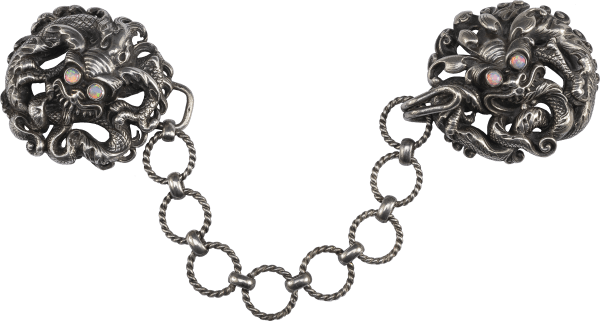


Brooch with Renaissance Lady
, France (Paris), c. after 1894
Brooch with Renaissance Lady
Description
Gold rectangular brooch with enameled decoration. In the central medallion with gold beaded border against a black background the profile bust of a Renaissance lady dressed in translucent red with green, gold edging embellished with pearls and in matching colors a headdress and white veil. The side panels are decorated with symmetrical scroll ornaments in gold, translucent green, and red enamel against an ivory-colored background. Along the rim of the brooch are clusters and single diamonds set in silver. On the brooch pin is the maker’s mark Alexis Falize, along with the French mark of the eagle’s head and the numbers ‘416’ (unexplained).
It comes as no surprise that Lucien Falize and his firm, fascinated by the art of enameling, teamed up with other artists specialized in painted Limoges-style enamels to produce brooches, pendants, watches, and bracelets adorned with circular plaques. This brooch, combining Falize’s cloisonné enamel with a Renaissance-inspired portrait of an aristocratic lady, is a particularly lovely example.
Falize was one of the first jewelers to incorporate independent translucent painted enamels into his jewels, employing freelance artists including Alfred Meyer, Charles LePec, Claudius Popelin, Paul Grandhomme, and Alfred Garnier. One of the most spectacular examples from the firm is the so-called Gaston Phebus necklace commissioned by the Prince de Béarn-Viana and completed in 1887. Alfred Meyer signed these portraits on the counter-enamel. Falize praises the work of Charles LePec for his use of gold plaque, instead of copper, as a background because it “animates the reds and enriches all the tones.” He used Claudius Popelin for smaller pieces including a necklace of Diana. Working for Falize at least from 1876 to 1891, Paul Grandhomme, with whom he became friends, also painted over paillons and supplied a ground for his figures of opaque blue, black, or brown enamel, as appears on our brooch. Lacking a signature, the present enamel portrait could be by one of Grandhomme’s assistants or followers.
Sixteenth-century engravings, such as by Virgil Solis (1514–c. 1562), with scrollwork and moresque ornaments on frieze decorations and inserted round medallions with historical figures, inspired the overall design of the brooch. Unusual is the three-dimensional application of the red enamel cloisons of the foliage on this brooch, which gives the appearance of gemstones, and the addition of diamonds demarcating the frame.
Literature:
compare Chadour/Joppien 1985, vol. I, pp. 400–403, no. 33 (necklace in the Museum für Angewandte Kunst, Cologne); exh. cat. Pariser Schmuck 1989, pp. 160–161, no. 91; Purcell 1999, p. 66, fig. 86, p. 106, figs. 153–154; Vever 2001, p. 956, fig. 98; exh. cat. Bijoux Parisiens 2013, pp. 82–83, no. 66 (for portrait medallions in Falize jewels); and O’Dell-Franke 1977, pls. 94–96 (h50-66), pl. 99 (h84-5), pls. 148–152 (m76-108) (for Virgil Solis engravings).
